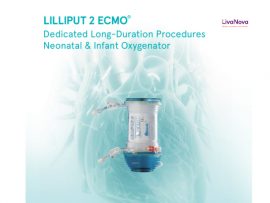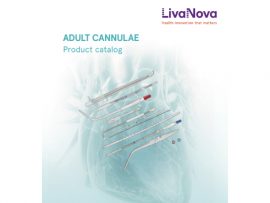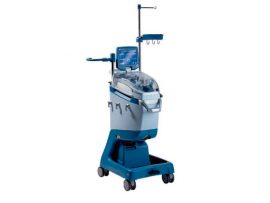Abstract Right ventricular failure (RVF) is a significant cause of mortality in patients undergoing left ventricular assist device (LVAD) implantation. Although right ventricular assist devices (RVADs) can treat RVF in..
Read MoreAbstract Objective. Diagnosis of incipient acute hypovolemia is challenging as vital signs are typically normal and patients remain asymptomatic at early stages. The early identification of this entity would affect..
Read MoreAbstract The lungs were long thought to be sterile until technical advances uncovered the presence of the lung microbial community. The microbiome of healthy lungs is mainly derived from the..
Read MoreAbstract Artificial intelligence (AI) is rapidly emerging in healthcare, yet applications in surgery remain relatively nascent. Here we review the integration of AI in the field of surgery, centering our..
Read MoreAbstract Artificial membrane lungs are composed of hollow fiber membranes. Blood flows with low velocities in the membrane bundle, forming a laminar boundary layer near the membrane surfaces that limits..
Read MoreAbstract Simulation plays a pivotal role in addressing universal healthcare challenges, reducing education inequities, and improving mortality, morbidity and patient experiences. It enhances healthcare processes and systems, contributing significantly to..
Read MoreAbstract This article explores the major challenges and specialized strategies involved in managing cardiovascular surgery patients who are Jehovah’s Witnesses and refuse blood transfusions due to their religious beliefs. It..
Read MoreAbstract According to the Extracorporeal Life Support Organization (ELSO) guidelines, pre-assembled and already primed extracorporeal membrane oxygenation (ECMO) systems can be safely stored for up to 30 days under specific..
Read MoreAbstract Introduction In healthcare teams, psychological safety is associated with improved performance, communication, collaboration and patient safety. Extracorporeal membrane oxygenation (ECMO) retrieval teams are multidisciplinary teams that initiate ECMO therapy for..
Read MoreAbstract Introduction Oxygenators for paediatric Extracorporeal Membrane Oxygenation (ECMO) are required to operate over a wide range of flow rates, in a patient group ranging from neonates through to fully..
Read MoreAbstract Cerebral blood flow (CBF) autoregulation is the physiologic process whereby blood supply to the brain is kept constant over a range of cerebral perfusion pressures ensuring a constant supply..
Read MoreAbstract Background The continuous exposure of blood to a non-biological surface during extracorporeal membrane oxygenation (ECMO) may lead to progressive thrombus formation in the oxygenator, hemolysis and consequently impaired gas..
Read MoreAbstract Introduction Extracorporeal membrane oxygenation (ECMO) emergencies require skilled clinical specialist (CS) who manage ECMO circuits. While tools for assessing CS skills have been published, there is significant variation in..
Read MoreAbstract Introduction Extracorporeal techniques have been present in medicine for over 70 years. Many factors in history have influenced their development and popularisation, in particular the first discoveries of heparin..
Read MoreAbstract OBJECTIVES: Measurement of blood pressure taken from different anatomical sites, are often perceived as interchangeable, despite them representing different parts of the systemic circulation. We aimed to perform a..
Read MoreAbstract Background Cannulation strategy in acute type A dissection (ATAD) varies widely without known gold standards. This study compared ATAD outcomes of axillary vs femoral artery cannulation in a large..
Read MoreAbstract Background Large cannulae can increase cannula-related complications during venoarterial extracorporeal membrane oxygenation (VA ECMO). Conversely, the ability for small cannulae to provide adequate support is poorly understood. Therefore, we..
Read MoreAbstract OBJECTIVES: To present recommendations and consensus statements with supporting literature for the clinical management of neonates and children supported with extracorporeal membrane oxygenation (ECMO) from the Pediatric ECMO Anticoagulation..
Read MoreAbstract This scientific statement presents a conceptual framework for the pathophysiology of post–cardiac arrest brain injury, explores reasons for previous failure to translate preclinical data to clinical practice, and outlines..
Read MoreAbstract Background Most cardiac surgery clinical prediction models (CPMs) are developed using pre-operative variables to predict post-operative outcomes. Some CPMs are developed with intra-operative variables, but none are widely used...
Read MoreAbstract Objective: Femoral artery cannulation is the most commonly used approach for cardiopulmonary bypass (CPB) in robotic cardiac procedures. However, without adding a distal perfusion cannula, leg ischemia can occur..
Read MoreAbstract This article advocates for an open communication culture in the perfusion and cardiothoracic community to enhance patient safety during surgery. All team members, including nurses, anesthesiologists, and perfusionists, should..
Read MoreAbstract Traumatic injury is associated with several pulmonary complications, including pulmonary contusion, transfusion-related acute lung injury (TRALI), and the development of acute respiratory distress syndrome (ARDS). There is a lack..
Read MoreAbstract Introduction Medication errors are an unnecessary cost to a healthcare system and patients of a country. This review aimed to systematically identify published cost variables used to calculate the cost..
Read MoreAbstract Background The relationship between postoperative adverse events and blood pressures in the preoperative period remains poorly understood. This study tested the hypothesis that day-of-surgery preoperative blood pressures are associated..
Read MoreAbstract Objective:This study aimed to evaluate the rate of transfusion for cardiovascular surgeries between 2010 and 2019 in Republic of Korea and the association between blood transfusion and postoperative mortality...
Read MoreAbstract Background Postpartum anemia is a significant contributor to peripartum morbidity. The utilization of cell salvage in low risk cases and its impact on postpartum anemia has not been investigated...
Read MoreAbstract Background Alternatives to allogeneic blood transfusions are sought for resource management reasons and it is necessary to investigate the efficiency and efficacy on Cell Salvage use. The objective of..
Read MoreAbstract A guideline for predeposit autologous transfusion was published in 2007. Practices have changed in the intervening years, and in line with British Society for Haematology (BSH) guidelines processes, this guideline..
Read MoreWatch the panel discussion and three case presentations during our next Global Grand Rounds webinar this Wednesday at 8am ET. Register for the replay:
Read More





















